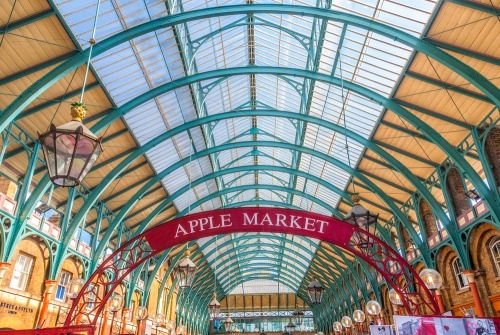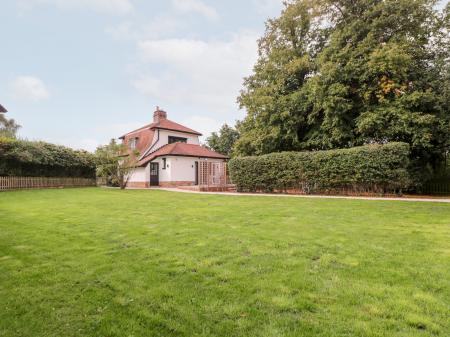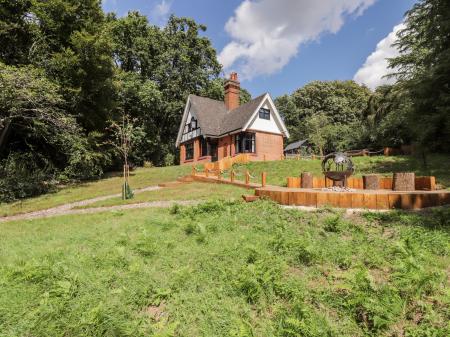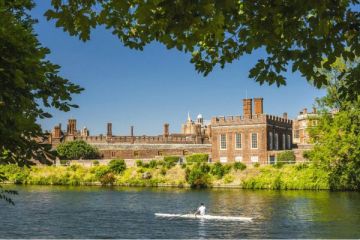
History
The market began very simply in 1656 when the Duke of Bedford allowed several temporary stalls to be built in the gardens of Bedford House, his London home. In 1670 the Duke was granted a license by Charles II to hold a market every day except Sundays and Christmas.
The Duke sold the license shortly afterwards, and by 1700 there was a regular thrice-weekly market selling fruit, vegetables, flowers, roots, and herbs from permanent shops erected against the garden wall.

Entertainment of various sorts regularly took place at Covent Garden. According to diarist Samuel Pepys, the very first Punch and Judy shows were held here in 1662. Around 1650 the first pineapples began to be grown in England, and so popular did the fruit become that it was adopted as the symbol of Covent Garden Market.
The area surrounding Covent Garden was quite posh, and the residents were by no means happy with the rather plebian market, a source, they thought, of noise and dirt. In 1748 the market was rebuilt by the Duke, at a cost of £4000. The shops gained upper stories, and the tone of the market was raised considerably.

The area around Covent Garden became synonymous with theatre and opera. The Theatre Royal on Drury Lane is just outside the market area, as is the Royal Opera House. St Paul's Church, on the west side of Covent Garden market, became known as the Actor's Church and was frequented by the leading lights of the stage. From 1798 the actors could indulge in fine food at Rules Restaurant on Maiden Lane. Rules is known as the oldest restaurant in London.
By the onset of the Victorian era, Covent Garden had grown considerably, not least due to the closure of competing markets. In 1828 the entire complex was rebuilt to a neo-classical design by Charles Fowler, into a bright, colourful, cheerful market, full of light and space. It was, oddly, a place where high society could intermingle with ordinary Londoners, farmers, and flower sellers.
The market was further expanded into five main areas, Russell Street, the Row, Flower Market, Charter Market, and Flower Hall. The Dukes of Bedford sold their interest in the market in 1918.
In 1974 the market moved to a new site at Nine Elms, Battersea (called New Covent Garden), but the original site has now been redeveloped into a thriving market once more, with cafes and a variety of shops under the colourfully painted Victorian market building.

What to See
St Paul's Covent Garden
The Actors' Church, known for its long links to London's theatre, stands on the western side of the piazza. It was designed in 1630 by Inigo Jones, the Court architect, for the 6th Earl of Bedford. The Earl didn't want to spend much money so he instructed his architect to build a church 'not much better than a barn'. Jones famously replied, 'Then you shall have the handsomest barn in England'.
The church interior is lined with memorials to generations of leading actors, actresses, musicians, choreographers, and set designers who plied their craft in London's West End theatres and worshipped at St Paul's Church.
The east facade of the church is notable for its huge neoclassical portico. It was here that Samuel Pepys watched the first Punch and Judy show in England. The portico was also a setting in George Bernard Shaw's play 'Pygmalion' (later adapted as My Fair Lady) where Professor Higgins meets Eliza Doolittle.

Punch and Judy Pub
Almost directly opposite St Paul's Covent Garden stands the historic Punch and Judy Pub, built in 1787 and named for the Punch and Judy puppet shows that were regularly performed in the Piazza to entertain the children of the flower-sellers.
The pub largely escaped the World War Two bombs that fell on Covent Garden and as a result, it retains much of its original 18th-century brick and stonework. The pub has an extremely popular balcony facing the church, perfectly situated for watching street theatre performers.
London Transport Museum
In the south-eastern corner of the Covent Garden piazza is the London Transport Museum, one of the most popular visitor attractions in London. The museum covers the history of transportation in London, from Tudor barges, Georgian sedan chairs, Victorian horse-drawn trams and, of course, the London Underground and the familiar red double-decker buses. The museum occupies a historic brick and glass building built in 1871 as part of Covent Garden's old flower market.

The Apple Market
Situated in the northern part of the covered market, the Apple Market hosts around 40 stalls selling a wide variety of goods. Don't be fooled by the name - the Apple Market is where you will find quality antiques, crafts, handmade clothing, and pictures. On Mondays, the Apple Market is focussed on antiques, but from Tuesday-Sunday you will find a wide variety of arts and crafts.

Street Theatre
The area around Covent Garden is probably the best place in London to enjoy street theatre, from busking musicians to jugglers, acrobats, and magicians. The area between the market and the portico of St Paul's Covent Garden is a frequent spot to catch some of London's finest street performers. Most of these performers are outstanding - just because you haven't seen them on television doesn't mean they aren't exceptionally talented!
High on the wall of a brick building on the south side of the market piazza is a small circular plaque, commemorating the working donkeys of Covent Garden. The plaque was erected in 1974 in memory of the over 100,000 costermongers' donkeys who worked in the Covent Garden area from 1661 to the present day.
In the market is Benjamin Pollock's Toy Shop. Pollock was a famous maker of toy theatres during the late Victorian period, with a shop in Covent Garden that opened in the 1880s. You can learn more about Pollock and see a wealth of historical toys, games and theatres at Pollock's Toy Museum on Scala Street.
Getting There
Covent Garden is extremely easy to reach by underground. The nearest stop is Covent Garden station on the Picadilly Line. From the station exit turn right onto James Street and you will see the market entrance directly ahead of you. It will take no more than 2-3 minutes from the station to the market.












 We've 'tagged' this attraction information to help you find related historic attractions and learn more about major time periods mentioned.
We've 'tagged' this attraction information to help you find related historic attractions and learn more about major time periods mentioned.



